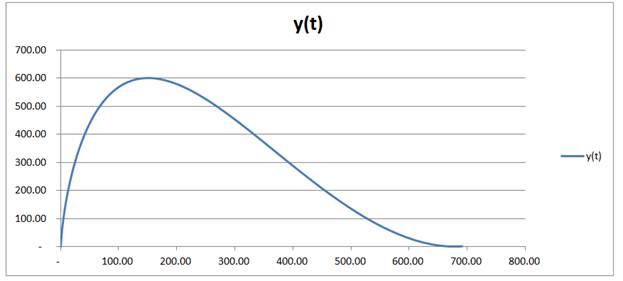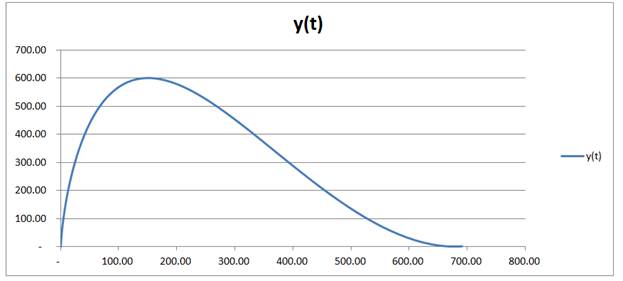
Concept explainers
Students are testing their new drone to see if it can safely deliver packages to different departments on campus. Position data can be approximated using the expressions
(a)
The duration of flight.
Answer to Problem 11.182RP
We got the time of flight is
Explanation of Solution
Given information:
Time
Concept used:
We shall draw graph (plot of path)
Calculation:
Following table is made-
| t | 0.00 | 1.00 | 10.00 | 20.00 | 30.00 | 39.00 | 40.00 | 50.00 | 60.00 | 70.00 |
| x(t) | 0.00 | 0.01 | 3.78 | 24.40 | 71.78 | 141.11 | 150.40 | 259.38 | 392.40 | 537.78 |
| y(t) | 0.00 | 0.93 | 87.89 | 300.06 | 512.20 | 599.08 | 600.00 | 512.02 | 299.82 | 87.72 |
| t | 79.00 | 80.00 | 81.00 | 82.00 |
| x(t) | 665.15 | 678.40 | 691.38 | 704.07 |
| y(t) | 0.91 | 0.00 | 0.94 | 3.73 |
Plot,

From above table and plot we get the take off and landing altitudes are the same at
Hence the time of flight is
Conclusion:
We got the time of flight is
(b)
The maximum speed in x direction.
Answer to Problem 11.182RP
We got the maximum horizontal speed
Explanation of Solution
Given information:
Time
Concept used:
Speed
For maximum speed
Calculation:
Speed
For maximum speed
On putting value of
Conclusion:
We got the maximum horizontal speed
(c)
The maximum altitude
The horizontal distance of the flight.
Answer to Problem 11.182RP
We get the maximum altitude,
And horizontal distance traveled,
Explanation of Solution
Given information:
Time
Concept used:
We shall draw graph (plot of path)
Calculation:
Following table is made-
| t | 0.00 | 1.00 | 10.00 | 20.00 | 30.00 | 39.00 | 40.00 | 50.00 | 60.00 |
| x(t) | 0.00 | 0.01 | 3.78 | 24.40 | 71.78 | 141.11 | 150.40 | 259.38 | 392.40 |
| y(t) | 0.00 | 0.93 | 87.89 | 300.06 | 512.20 | 599.08 | 600.00 | 512.02 | 299.82 |
| t | 70.00 | 79.00 | 80.00 | 81.00 | 82.00 |
| x(t) | 537.78 | 665.15 | 678.40 | 691.38 | 704.07 |
| y(t) | 87.72 | 0.91 | 0.00 | 0.94 | 3.73 |
Plot,

From above table and plot we get the maximum altitude,
And horizontal distance travelled,
Conclusion:
We get the maximum altitude,
And horizontal distance travelled,
Want to see more full solutions like this?
Chapter 11 Solutions
Vector Mechanics For Engineers
Additional Engineering Textbook Solutions
Starting Out with Java: From Control Structures through Objects (7th Edition) (What's New in Computer Science)
Modern Database Management
Elementary Surveying: An Introduction To Geomatics (15th Edition)
Starting Out with Programming Logic and Design (5th Edition) (What's New in Computer Science)
Mechanics of Materials (10th Edition)
Database Concepts (8th Edition)
- The system shown below is in statics equilibrium. Cable OB lies in the xy plane and makes a 30° angle with the positive x-axis. Cable OA lies along the negative y-axis. If the weight of the load being supported is 100 lb, determine the magnitude of the forces in all four cables: OA, OB, OC, and OD.arrow_forwardThis is a mechanics/statics problem involving finding internal reactions, V(x) and M(x). Please refer to image for details. I'm not sure about where to take cuts and how to formulate the equations as a function of x. For my support Reactions I got Ay = 1008.33 lb, By = 1416.67 lb and Cy = 175 lb. and for the first cut V(x) = 1008.33 -250(x) and M(x) = 1008.33x - 125x^2. I'm struggling with the equations for the 2nd and 3rd cut.arrow_forwardAs shown in the figure below, a ring is used to suspend a load and is supported by Cable OA and Spring OB. Given that the tension in Cable OA is 400 N, what is the weight of the load being supported? Assume the system is in static equilibrium.arrow_forward
- 4. (a) State the conditions that must be met to ensure dynamic balance is achieved for long rotors. (b) A rotor carries three out-of-balance discs in planes A, B and C as shown in Figure 4. The out-of- balance mass x radius products of the rotor discs are tabulated in Table 4. The shaft is to be dynamically balanced by adding balancing masses in planes P and Q, spaced along the shaft at a distance da = 800 mm. Determine the magnitude mara and angular position of the balancing mass x radius product that must be added to plane Q. MBB Ов θε mdc Мага End View on Plane P P MBB MATA dA dB dc do Figure 4 moc Table 4 MATA = 0.6 kg mm 6A = 0° d₁ = 200 mm mers = 0.2 kg mm 6g = 45° dB = 400 mm mcrc = 0.4 kg mm Bc=240° dc = 600 mm Ans. (b) = 110.5°, moro = 0.2 kg mmarrow_forwardNeed help in adding demensioning am am so confusedarrow_forwardComplete the following activity. Save as .pdf and upload to the assignment to the dropbox. 口 Use the general dimensioning symbols to correctly specify the following requirements on the drawing above.arrow_forward
- please solve and show workarrow_forwardWater is boiling in a 25 cm diameter aluminum pan (k=237 W/mK) at 95 degrees C. Heat is transferred steadily to the boiling water in the pan through its .5 cm thick flat bottom at a rate of 800 W. if the inner surface temp of the bottom of the pan is 108 degrees C determine the boiling heat transfer coefficent on the inner surface of the pan and the outer surface temp of the bottom of the pan.arrow_forwardplease solve and show workarrow_forward
- please solve and show workarrow_forwardA thin plastic membrane separates hydrogen from air. The molar concentrations of hydrogen in the membrane at the innner and outer surfaces are determined to be 0.045 and 0.002 kmol/m^3 respectiveley. The binary diffusion coefficent of hydrogen in plastic at the operation temp is 5.3*10^-10 m^2/s. Determine the mass flow rate of hydrogen by diffusion through the membrane under steady conditions if the thickeness of the membrane is 2mm and 0.5 mm.arrow_forwardCalculate the vertical cross section moment of inertia for Orientations 1 and 2. State which number is the higher moment of inertia using equation 1. Given: b1=1 in, h1=1.5 in, b2=1.5 in, h2=1 in, t=0.0625 in. Then calculate the maximum deflection for a point load of 8 lb on the free end of the beam using equation 2. Given: E=10.1*10^6 psi. 1. ((bh^3)/12) - (((b-2t)(h-2t)^3))/12) 2. S = (PL^3)/(3EI)arrow_forward
 Elements Of ElectromagneticsMechanical EngineeringISBN:9780190698614Author:Sadiku, Matthew N. O.Publisher:Oxford University Press
Elements Of ElectromagneticsMechanical EngineeringISBN:9780190698614Author:Sadiku, Matthew N. O.Publisher:Oxford University Press Mechanics of Materials (10th Edition)Mechanical EngineeringISBN:9780134319650Author:Russell C. HibbelerPublisher:PEARSON
Mechanics of Materials (10th Edition)Mechanical EngineeringISBN:9780134319650Author:Russell C. HibbelerPublisher:PEARSON Thermodynamics: An Engineering ApproachMechanical EngineeringISBN:9781259822674Author:Yunus A. Cengel Dr., Michael A. BolesPublisher:McGraw-Hill Education
Thermodynamics: An Engineering ApproachMechanical EngineeringISBN:9781259822674Author:Yunus A. Cengel Dr., Michael A. BolesPublisher:McGraw-Hill Education Control Systems EngineeringMechanical EngineeringISBN:9781118170519Author:Norman S. NisePublisher:WILEY
Control Systems EngineeringMechanical EngineeringISBN:9781118170519Author:Norman S. NisePublisher:WILEY Mechanics of Materials (MindTap Course List)Mechanical EngineeringISBN:9781337093347Author:Barry J. Goodno, James M. GerePublisher:Cengage Learning
Mechanics of Materials (MindTap Course List)Mechanical EngineeringISBN:9781337093347Author:Barry J. Goodno, James M. GerePublisher:Cengage Learning Engineering Mechanics: StaticsMechanical EngineeringISBN:9781118807330Author:James L. Meriam, L. G. Kraige, J. N. BoltonPublisher:WILEY
Engineering Mechanics: StaticsMechanical EngineeringISBN:9781118807330Author:James L. Meriam, L. G. Kraige, J. N. BoltonPublisher:WILEY





